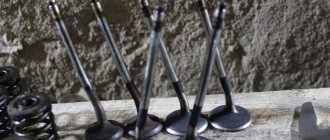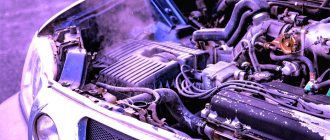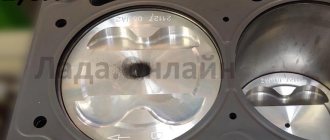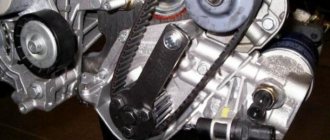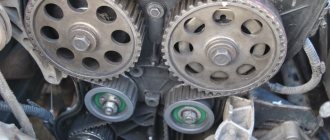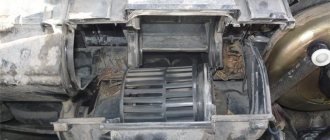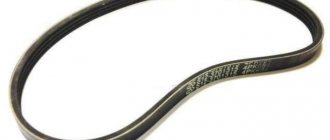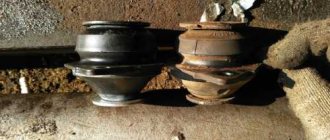VAZ cars of the 2112 family were produced with one of four engines. Two of them are 8-valve, two more are 16-valve. 8-valve engines have pistons with grooves, and therefore the valves cannot bend. But this property does not apply to any Lada passenger cars: almost all 8-valve engines began to bend their valves when moving to the Grant family. It is known which of the VAZ-2112 engines never bends the valves - the engine 21124 (1.6 16v) remains .
Look how difficult it is to change valves on the Ten. All steps in one video
Domestic 16-valve engines
A little preface. When faced with 16-valve VAZs at the household level, remember that such cars are always equipped with 14-inch wheels, since there are enlarged ventilated brake discs at the front.
So, the “gear” came from an 8-valve engine. In the articles you can find mentions that VAZ wanted to create a powerful and economical engine, and so, the “gear” will never be more economical than an eight-valve engine. Consumption 16 cl. engine 7.5 - 10 liters, depending on the dynamics.
The first engine from the line was 21120 (hereinafter referred to as the 120th
). The volume is one and a half liters, equipped with an ignition module, the valves bend. Visually different is the cast intake manifold. It was developed for cars 2110-2112, installed in various modifications such as “Premier” and 2112 in a two-door hatchback body. It went into production in 1996 and was installed on cars until 2004. If today you buy a car with such an engine, then most likely it has already undergone repairs and a “plug-in” piston is installed on it.
In 2004, the 120th engine was replaced by a new one with the index 21124 (hereinafter referred to as the 124th
). In addition to cars of the tenth family, it was installed on the VAZ 2113 and VAZ 2114.
This engine does not bend the valves, thanks to grooves on the pistons, this is its main difference from its predecessor. It is easy to distinguish by its plastic intake manifold. In addition, the ignition module has been replaced with individual coils for each cylinder. Engine capacity increased to 1.6 liters.
Many people call this engine the most balanced in the VAZ line, and I think this is true. Its service life is at least 200 thousand, if you drive “without fanaticism”.
In 2007, the tenth family left the assembly line (the vehicle kits were sent to Ukrainian as punishment) and the Priora was released. This “breakthrough” in mechanical engineering was equipped with the 21126 engine ( 126th
). It was equipped with lightweight connecting rods, pistons, liners, and other parts, which made its service life less than that of a 124 engine. In order to increase power, the grooves on the pistons have been removed and the valves on this engine are bent.
21128 or 128th
the motor was created and installed on Priora and 2110-2112, which were produced by this company. This is the heir to the 124th engine, the engine capacity has been increased to 1.8 liters, which has a negative impact on the service life. In practice, I saw one such car, which, with a mileage of 90 thousand kilometers, suffered from severe oil consumption. This engine received a lot of negative reviews.
In 2013, 21127 appeared or 127
-th engine, its power was increased to 106 horsepower, an adjustable air intake through the receiver was installed, the mass air flow sensor was abandoned in favor of the DBP (absolute pressure sensor) and the DTV (air temperature sensor). The valves in this engine are bent.
And the last creation we will look at is this 11194
engine. It has a volume of 1.4 liters, installed on Kalina. At one time I drove such a Kalina, and the meaning of such an engine is not clear to me; it drives exactly the same as an 8-valve one. The reviews leave much to be desired, and for its unjustified oil consumption, the engine was nicknamed the “legendary Kalinomotor”, of course, not without sarcasm.
We briefly looked at the "six" from VAZ. In this article I will not touch on modern Vest engines and other creations of AVTOVAZ; to be honest, I’m losing interest in studying the crafts of the alliance of the French and Japanese.
If the article was interesting, then give it a thumbs up and subscribe to the channel.
Source
Self check
If you want to know for sure whether the valve will bend when the timing belt breaks or not, you can do independent diagnostics. It is carried out with the engine turned off:
- Remove the protective cover from the side of the motor.
- Remove the timing belt.
- Carefully rotate the camshaft. If at a certain moment you feel that it has rested against something, it means that the valves on the broken belt will definitely bend.
Such diagnostics can only be carried out on internal combustion engines with special marks on the camshafts, and this method is not accurate.
If your belt has already broken, you can find out its working condition by measuring the compression on each of the cylinders. This is done after installing a new timing belt on a running internal combustion engine.
Do the valves on the Lada Granta 8 valve bend: 11186 (82 hp) and 21116 (87 hp), + video?
Options for 8-valve engines are well known to Lada Granta owners from previous AvtoVAZ models. These engines have indexes 11183 and (11186, 21116), their power is 82 and 87 horsepower, respectively.
Main article: What engines are installed on Lada Granta cars.
Domestic consumers are very afraid of a broken timing belt. Therefore, this issue plays an important role when choosing a car modification.
In the event of such a situation, bending of the valves may occur, which has given rise to the popular saying “fist of friendship.” There is even slang that refers to motors that bend valves as “plug-in”, and motors that do not have this disadvantage as “plug-in”.
To prevent the belt from breaking, it is necessary to change the belt on time (read more about when it is necessary to change the timing belt according to the recommendation of the factory and the experience of Grantovodov here).
Modification 11183 (Standard package, 82 hp)
Engine 11183 (under the hood of Lada Kalina)
The very first modifications of the Grant car came with a non-lightweight connecting rod and piston group; on such engines the valves do not bend, it all depends on the speed at the moment the belt breaks. These engines were installed on cars in the “Standard” configuration and had the designation 11183. The advantage of this engine is its high-torque power; at the bottom it drives like a diesel engine!
In fact, this is a complete copy of the VAZ-2108 engine, only with an increased volume, and the owners of the nines boasted about stories about how the timing belt broke and nothing happened to the engine.
Engine 11186 (87 hp) - the valves bend!
Engine 11186 (under the hood)
11186 engine specially for CarFrance.ru from Grantovod Igor
When the timing belt breaks on engine 11186 of a Lada Granta, the valves bend; there have already been many cases that have confirmed this hypothesis. The most successful scenario for the development of events in the event of a timing belt break on this engine is the bending of the intake valves.
Engine 11186 (removed from the car)
Engine 21116 (87 hp) - the valves bend!
21116 engine bends valve
This engine is installed on the Lada Granta in the “Norma” configuration. And it also bends the valves, unfortunately.
Main article: Engine 21116: reviews, service life before major overhaul - a detailed review of the engine from Grantovodov!
Engine 21116 (87 hp) is one of the most common in Lada Granta cars.
In order to increase power, AvtoVAZ designers had to install a lightweight piston group in the 114 engine. This has led to the fact that the space for the recesses in the pistons is now completely absent, which means that the piston will 100% bend. Since the piston has become thinner, with a high degree of probability the piston, after “meeting the valves,” will also become unusable and fall apart.
The only difference between 21116 and 11186 is that the first is installed with an imported connecting rod and piston group, and the second with a domestic one.
Repair (cost, warranty)
Repair in the simplest situation will start at 15 thousand rubles, depending on the region and the qualifications of the technician. The saddest thing is that these situations also arise at short mileage, about 15,000 km. But in this case, you can still contact your official dealer for warranty. This type of work is guaranteed.
Since when the timing belt breaks, the valves also break on 16 valves, a heated discussion has developed on our website about which engine is better: 8 or 16 valves.
How to check the condition of the timing belt?
To visually check the timing belt, you must remove the timing cover. This is not difficult to do; with 8 valves there is a lot of space under the hood. Remove the cover and begin a visual inspection of the belt. It should be like new, without cracks or rips, without dirt or deposits, and dry.
If the condition of the belt causes concern, then it must be replaced, for more details, see the article: replacing the timing belt on an 8-valve Granta.
How to check the condition of the pump and tension pulley?
To check the condition of the pump, it is necessary to remove the lower half of the timing cover. Next, release the belt tension by loosening the tension roller. Check the functionality of the pump, spin it and see if there is any play. If there is play, then do not delay and change the pump, as it may jam in the near future.
The tension roller is checked for play in the same way.
You should also be alerted to extraneous noises when the engine is running. A sign of imminent failure of the pump and rollers is the sound of “rustling” of these elements.
There have been cases of timing belt breakage and valve bending as a result of a jammed pump and on a mileage of no more than 20,000 km.
carfrance.ru
Why does the belt break?
The valve bends when the timing drive breaks, so it is important to monitor its condition. On 11186 AvtoVAZ installs Gates belts art. 5670XS with automatic tensioner art. T43228
According to the manufacturer, the service life of the consumable is equal to the engine service life - 200,000 km. In reality, the belt runs about 50,000 km. Experts recommend checking the part during each maintenance, after 15,000 km
5670XS with automatic tensioner art. T43228. According to the manufacturer, the service life of the consumable is equal to the engine service life - 200,000 km. In reality, the belt runs about 50,000 km. Experts recommend checking the part during each maintenance, after 15,000 km.
In addition to the quality of the belt, how it is tensioned is also important. In engine model 11186, when backlash or jamming occurs in the pump or tension roller, the belt cuts off the teeth and the pistons bend the valve. It cuts teeth instantly, so it’s rarely possible to avoid breakage.
It cuts teeth instantly, so it is rarely possible to avoid breakage.
Quality of spare parts
Gates has been cooperating with AvtoVAZ since 2003. The company's products are not cheap. A set of timing belt and tension pulley will cost at least 3,000 rubles. Is it worth saving and buying a cheap Chinese equivalent if there is a danger that if the drive breaks, the engine bends the valve?
However, even if you want to buy an original product, you can run into a fake. Under the name Gates there are counterfeits made from cheap material at a dubious price. You need to buy spare parts from official distributors. Addresses can be found on the company website.
The original timing belt is made of hydrogenated heat-resistant rubber with high resistance to various chemicals. The part has a rounded toothed profile. There are 113 teeth, 17 mm wide. Length - 1.076 m.
Belt wear is determined by the quality of the material, the presence of cracks and delaminations. The surface of the part should be elastic, not too hard. It is not permissible to stretch or shift the belt relative to the required position, otherwise it will fly off and a situation will occur in which the valve bends.
Incorrect belt installation
On a Grant with engine 11186, the valves bend in case of any damage to the timing drive. Since the slightest loosening of the belt causes teeth to be cut off, the drive must be installed strictly according to the diagram, using a special key.
If you look at the drive tension, then on the right side from the camshaft to the crankshaft you get a long arm in a free state. The force is from 15 to 20 Nm. Next, the belt covers the crankshaft sprocket. It rises to the water pump, going around the gear on the left. It goes to the tension roller on the right and returns to the camshaft.
Do 16 valve engines bend?
Motors 21120 and 21124 are similar in design, but their displacement is different. The pistons are also installed differently - there are differences in the depth of the grooves.
ShPG elements (pistons) 2112-1004015 and 21124-100401504
In pistons 2112-1004015, the grooves are actually made. The likelihood of bending is reduced, but it is not reduced to zero
Therefore, always pay attention to the quality of the pump and rollers when replacing the timing belt on a 16-valve engine
- 2112-1004015 – piston of the VAZ-21120 engine (1.5 16v);
- 21124-100401504 – piston of the VAZ-21124 internal combustion engine (1.6 16v).
Don't make the wrong choice.
Motors 21124 are in short supply!
One of the most favorite engines in the 12 is the 124. It doesn’t bend valves, drives great, and what else do you need?
The number of VAZ-21124 engines produced over the entire period is difficult to calculate. Maybe it even exceeds the number of 20 engines. Engine 21124 had a Euro-4 version, and this engine, regardless of the version, is in short supply. Prices also remain high. Well, the less voluminous 16-valve engine is rated lower, despite the fact that it is more powerful!
Belt drive failures
- belt break . Can be caused by wear, as well as excessive tension and wear on the tension and parasitic rollers;
- belt slippage due to cutting of teeth or breakage of the tension roller spring (if it is provided for in the design). Cut teeth may not be immediately detectable;
- cutting off one of the gear keys or breaking the keyway;
- On some engines, the camshaft gears have a conical fit, that is, only the tightening torque of the bolt serves as insurance against gear rotation. (One master failed to get such a gear. To my question: “So what?” was the answer: “twelve out of sixteen.” This meant bent valves, of course.)
How to find out if the valves on the engine are bent?
Many people ask me this question: “Perhaps there are some tricks or signs by which you can distinguish a “bending” engine from a non-bending one?”
Guys, unfortunately there are no such people! It is practically impossible to determine visually. There are no inscriptions or other references anywhere. The first way to determine this is to go to an official dealer - 100% information. You can also find information on the Internet (for example, on thematic forums) about your engine model, and really see whether it’s oppressive or not.
That's all for me, I think my article is useful to you. Read our AUTOBLOG.
Similar news
- Secret bolts, nuts
- How often should you change the fuel filter? Let's look at a separate variant...
- How to remove the bumper of a Hyundai Solaris. Let's disassemble the front part, photo...
About the engine
For these models, engines 2108 and 21083 were taken as the basis. They are 2-cylinder engines with an in-line vertical arrangement of cylinders. The camshaft is installed in the cylinder head. The working volume is 649 cm 3 and 749 cm 3. The increase in volume is obtained by increasing the diameter of the pistons from 76 mm to 82 mm. The cylinder blocks of these engines, heads, flywheels, and pulleys are different.
Many spare parts are unified with their 4-cylinder variants. The power supply system is carburetor, but with changed calibration data. In 1990, the timing belt on the power unit was replaced. If the previous product had semicircular teeth, then on the new one they began to have a trapezoidal shape with a groove at the top of the tooth. The pulleys were changed to match the tooth profile, but the belts themselves are interchangeable; you can use both new and old parts.
Video with an example of tuning: increasing the volume from 1.5 to 1.6
In general, I decided to combine them into one post.
Tuesday…
There were no signs. The belt was top-notch. I would definitely have gone another 10k.
And then he suddenly bursts. It’s good that it didn’t tear on the climb, otherwise it would have been lost.
Well, OK. Replaced. I set the marks.
...but it doesn’t start. He farts, he farts, if you give it gas it’s like he’s screaming on two boilers. I tried to rev it up, started to keep the revs, but it stalled like half the boilers. And this never happened again.
Bent valve signs
When the belt breaks, simply changing the timing belt, hoping that everything went without consequences and you will start the engine, is not worth it. Especially if the engine is on the list of those on which the valves bend. Yes, there are cases where the bend was not large and several valves no longer fit snugly in the seat, then you can turn it with a starter, but often such actions will further aggravate the situation. Since with minor damage everything will work and spin, but the engine will shake, and the consequences will only get worse.
It is best if you remove the “head” in order to check this visually or fill it with kerosene, however, there are several ways to check whether the valve is bent without disassembling the engine.
Main symptom
if the valves are bent, there is little or no compression
. Therefore, it is necessary to measure the compression in the cylinders. But, such actions are relevant if the crankshaft can be turned and nothing rests anywhere. So the first thing you need to do is install a new belt, manually, using the bolt on the CV, turn the entire gas distribution mechanism a few turns (you need to unscrew the spark plugs).
How to check if a valve is bent
To determine whether any valve stem is bent, literally five turns of hand turning the crankshaft bolt with a wrench will be enough. If the rods are intact, the rotation will be free; if the rods are bent, the rotation will be heavy. There should also be clearly perceptible 4 points (with one revolution) of resistance to the movement of the pistons. If such resistance is imperceptible, then screw the spark plugs back in, unscrew them one by one and turn the crankshaft again.
Based on the manual torsion force, with one of the spark plugs missing, it is relatively easy to understand in which specific cylinder the valve(s) were bent. However, this method will not always help to accurately determine whether the valve is bent or not.
If the crankshaft rotates freely, then you can check it with a compression gauge
. Don't have such a tool? So do a pneumatic test
, and checking the tightness of the cylinders is the most correct way, which will give an answer to how the valve plates fit in the seats, without additional consequences when cranking with the starter and without installing a new belt.
How to check if the valve is bent yourself?
For a pneumatic test, there is no need to take the car to a service station; you can find out for yourself whether the cylinder is sealed or not. The easiest way is:
- select a piece of hose according to the diameter of the spark plug well;
- unscrew the spark plug;
- set the cylinder piston to top dead center (valve closed) one at a time;
- insert the hose tightly into the well;
- Trying with all your might to blow into the combustion chamber (air passes through - it’s bent, doesn’t pass through - “blown away”).
The same test can be done using a compressor (even a car compressor). True, you will have to spend a little more time, as you need to prepare. Drill out the central electrode in the old spark plug, and put a hose on the ceramic tip (fix it well with a clamp). Then pump pressure into the cylinder (provided that the piston in it is at TDC).
The hissing sound and pressure on the pressure gauge will tell you whether the valve caps are seated or not. Moreover, depending on where the air goes, determine the inlet bent or exhaust. When the exhaust outlets are bent, air goes into the exhaust manifold (muffler). If the intake valves are bent, then into the intake tract.
avtoexperts.ru
One of the scary topics in the conversations of motorists is why valves bend, on which cars this breakdown is possible, and how to prevent it. Today we will talk in detail about the reasons why engine valves fail and measures to prevent this malfunction.
What are the valves in the engine responsible for?
First, a little theory. Surely every car enthusiast knows how many cylinders are in the engine of his car, but how many valves are in it - not everyone will answer this question. Most modern engines have from eight to sixteen valves (two or four per cylinder); there are power plants (eight or twelve cylinders) in which the number of valves is from 24 to 32.
The valve is an important part of the gas distribution mechanism (GRM) of a car engine, which is located in the cylinder head and is responsible for the timely supply of air into the cylinder and displacement of exhaust gas from it.
Moreover, the same valve cannot perform these functions, and therefore each cylinder is equipped with two types of valves - inlet valves, which supply air to the combustion chamber, and exhaust valves, which squeeze out the combustion products of the air-fuel mixture from this chamber.
There are engines that have two exhaust and intake valves per cylinder, and there are those with more intake valves than exhaust valves (three and five valve cylinders). The valve structure consists of two parts: a plate and a stem. It is the valve stem that comes under attack when one of the elements of the gas distribution mechanism fails.
The valves are brought into working condition by the camshaft, which, rotating around its axis in the cylinder head, raises some and lowers other valves into the cylinders - these are the so-called gas distribution phases. In turn, the camshaft is driven by the crankshaft - both of these timing elements are interconnected by a drive, which can be geared, belt or chain. A gear drive rotates the camshaft in the cylinder block, and a belt or chain drive rotates in the cylinder head.
Currently, the most widely used engines are those that use a belt or chain in the gas distribution mechanism. The belt drive type is simpler in design, but less reliable than the chain drive. The chain drive type, in turn, is more complex - its mechanism includes tension rollers and dampers. It is no coincidence that we paid so much attention to the details of the gas distribution mechanism - understanding the principle of its operation will help us in the future to determine the reasons why the valve bends.
Why do valves bend?
With both a timing mechanism with a belt drive and a timing mechanism with a chain drive, there may come a time when the belt or chain drive fails. A broken timing belt or stretched timing chain links that are unable to engage the teeth of the camshaft gears (slippage) causes the camshaft to stop abruptly while the crankshaft continues to move.
At this moment, the valves are recessed into the cylinder, and the piston rises towards them. The lifting force of the piston is much greater than that of lowering valves, so the piston hits the valve plate, and the rod, unable to withstand this impact, bends or even breaks. The engine stops completely, and it is not recommended to start it again, so as not to provoke a more serious breakdown - failure of the pistons, which can lead to costly repairs to the cylinder head.
How to determine if the valves are bent
It is impossible to determine by eye that the valves are bent if the belt breaks or the timing chain slips. To do this, you need to carry out two simple operations.
To begin, install a new timing belt on the rollers according to the marks and slowly rotate the crankshaft. Two to five turns are enough to determine that the valves are bent: if the rotation is free, then the valve stems are intact; if it is difficult, the valves are bent.
It happens that the crankshaft rotates, but the valves are still bent. How to determine the breakdown in this case? It is necessary to measure the compression in the cylinders by first unscrewing the spark plugs. If there is no compression in the cylinder, the valves are bent.
How to prevent valve failure
Let's look at the reasons why the belt could break in order to understand how to prevent such a breakdown.
Reason 1: The timing belt has expired. Like any other consumable, the timing belt has its own service life. The car manufacturer indicates in the operating manual the timing belt replacement period - for most engines it occurs after a mileage of 100-120 thousand kilometers. Of course, you can hope that until this moment the belt will serve faithfully, but to be sure, we recommend that at each scheduled maintenance you inspect the condition of the belt and, if necessary, replace it. In this case, we will not allow it to break, and, as a result, we will not deal with problems with bent valves.
Reason 2. Using a counterfeit timing belt. Some car enthusiasts, wanting to save money, buy non-original, cheap timing belts, which break at low mileage - 5-7 thousand kilometers. Advice - be responsible when purchasing a timing belt; it is better to pay more for this consumable than to later fork out for expensive repairs to the cylinder head.
Reason 3. Timing pump failure. In the design of the gas distribution mechanism of some engines, the pump comes into contact with the belt, and if this unit fails, it jams, as a result of which the belt rubs against the pump and frays, which leads to its breakage. The pump wears out at the same mileage as the timing belt, so when replacing the belt, we recommend installing a new pump.
Reason 4: Camshaft wear. This breakdown occurs over long engine runs (150 thousand km or more), and therefore does not occur so often. A seized camshaft can cause the timing belt to break. That's why when buying a used car with high mileage, we strongly advise you to look at the condition of the camshaft.
Reason 5. Malfunction of the timing drive attachment. The timing belt moves on rollers, which can also wear out and jam, which leads to the belt breaking and the valves bending.
We recommend checking the condition of the tension rollers at each maintenance, regularly lubricating and tightening their fastenings, and, if necessary, replacing them with new ones.
Although engines with a timing chain drive are considered more reliable, it happens that valves bend in them too. This happens for two reasons: the chain links stretch or the drive attachments (tension rollers and dampers) fail. The main reason why timing chain links stretch is the poor-quality material from which it is made. Such a disaster happened to Volkswagen TSI engines in the mid-2000s: the German automaker ordered chains from an unscrupulous contractor, and they began to fail at 20-40 thousand kilometers, causing the valves to bend. To prevent valves from bending in such engines, the timing chain and attachments should be periodically diagnosed and, if necessary, replaced with new ones.
Engine VAZ 11183-1000260. Characteristics of the VAZ 11183 engine.
The engine is four-stroke, with distributed fuel injection, in-line, with an overhead camshaft. The engine cooling system is liquid, closed type, with forced circulation of liquid. The engine has a combined lubrication system: pressure and splash.
| Number of cylinders: | 4 |
| Cylinder displacement, l: | 1,596 |
| Compression ratio: | 9,6-10 |
| Rated engine power at a crankshaft speed of 5200 rpm: | 60 kW.-(82 hp.) |
| Cylinder diameter, mm: | 82 |
| Piston stroke, mm: | 75,6 |
| Number of valves: | 8 |
| Minimum crankshaft speed, rpm: | 800 – 850 |
| Maximum torque at 2500-2700 rpm, N*m: | 120 |
| Cylinder operating order: | 1-3-4-2 |
| Octane number of gasoline: | 95 (unleaded) |
| Fuel supply system: | Electronically controlled distributed injection |
| Spark plug: | A17DVRM, BPR6ES(NGK) |
| Weight, kg: | 112 |
Overheating temperature of the VAZ 11183 engine: operating 95°. The cooling system has a volume of 7.8 liters.
Engine Features.
The VAZ 11183 engine can be used for installation in VAZ Lada Kalina cars and its modifications.
Engine 11183 is an eight-valve four-cylinder power unit with a volume of 1.6 liters.
It should be noted that the 11183 engine in terms of the design of the main components: block, cylinder head, camshaft, valve mechanisms and crank mechanism does not differ from the VAZ 21114 internal combustion engine version.
A new cylinder block mod. 11183-1002011-10. Structurally, it differs from the 2110 cylinder block only in height. (see “Cylinder block”) To increase the engine volume, it was necessary to increase the height of the block by 2.3 mm (the height from the axis of the crankshaft to the upper surface of the block is 197.1 mm). The mounting holes for attaching the block head are made with M12 x 1.25 mm thread. The nominal diameter of the cylinders is 82 mm.
The engine uses a crankshaft mod. 11183-1005016. In terms of seats, it corresponds to the crankshaft 2112. This shaft has a crank radius increased by 2.3 mm, compared to the 2112 shaft, this provides a piston stroke of 75.6 mm. The shaft is marked: the model “11183” is indicated on the counterweight.
The flywheel and crankshaft pulley are used from the 2110 engine.
The engine uses a connecting rod and piston group 2110.
In order not to increase the compression ratio, the shape of the combustion chamber was increased and improved. The cylinder head with an enlarged combustion chamber received the index “11180”. There is a corresponding marking on the tide of the head.
There are a number of design solutions that distinguish the VAZ 11183 engine from the VAZ 21114 engine.
The electrical system uses a generator 5132.3771 (90 A). A new bracket was used to mount the generator. The generator belt tensioning mechanism is original.
The VAZ 11183 engine is equipped with a serpentine alternator belt 1118-1041020 – 6RK882 (882mm).
One of the latest improvements in the domestic automobile industry is the VAZ 11183 engine. It was originally developed as a replacement for the morally and technically outdated ICE 2108 model and its modifications. But, subsequently, VAZ 1118 Kalina cars began to be equipped with these power units.
Design nuances
Thanks to standard solutions from the AvtoVAZ manufacturer, engine 21124 received the following design features:
- ICE cylinder block used from 11193 with a height of 197.1 mm (“high”);
- threaded holes for the cylinder head have a size of M10 with a pitch of 1.25 mm;
- oil nozzles for cooling the pistons are installed in 2, 3, 4 and 5 main bearing supports;
- a crankshaft from 11183 was used, providing a piston stroke of 75.6 mm with a crank radius of 37.8 mm, respectively;
- pulleys on the crankshaft and camshaft are used from 2110;
- the timing belt was taken from 2112, that is, the basic version;
- connecting rods from 2110 together with pins;
- hydraulic pushers in the timing mechanism.
Crankshaft 11183
The modernization of the previous version has been preserved - a multifunctional damper:
- its toothed disk allows the DPKV sensor to monitor the position of the crankshaft;
- torsional vibrations are reduced;
- attachments are activated.
Crankshaft damper
Compression and oil scraper rings are used from 21083, steel or cast iron. Do-it-yourself boosting is allowed by modifying the intake/exhaust system, grinding the cylinder head and boring the cylinders to 86 mm.
Priora engine tuning
To improve the power performance of the Priora power unit, they resort to the following modifications:
- The receiver is installed.
- Exhaust pattern: 4-2-1.
- Throttle valve: 54 -56 mm.
- Sports camshaft.
- Modification of the cylinder head (cylinder head) by sawing.
- Lightweight valves.
- 440cc type injectors.
In addition to the considered method of transforming the power unit to increase dynamic performance, there are several more ways to tune a car of this model.
The first VAZ 2110 cars were produced with an 8-valve engine with a volume of 1.5 liters, and later with a 1.6 liter engine. On such units, when the timing belt breaks, the valves do not bend. This is explained by their absence in the piston. In the tenth generation, VAZ 2112 cars appeared with a 16-valve engine and a volume of 1.5 liters. With the release of this model, many car owners began to encounter problems with valve bending on the Priora. The design of the new motor has changed. Due to the 16-valve head, the power of this unit increased from 76 hp. up to 92 hp However, the big problem with such a motor is 21126 valve bending on the Priora. As a result, the car needs major repairs.
The reason why the valves in the Lada Priora were bent is the absence of special piston grooves in the 1.5 engine with 16 valves. Because of this, when the belt breaks, the pistons hit the valves, which bend them. Somewhat later, 16-valve 1.6-liter engines began to be installed on Priora. The design of these engines is practically no different from the previous ones with a volume of 1.5 liters. The main difference is that the new engine has recessed pistons. If the timing belt breaks, the pistons do not meet the valves, and the engine does not bend the valves on the Priora.
The modern engine from AvtoVAZ is presented in the form of a 16-valve unit, which differs from previous analogues in its reliability and safety; bent valves are not typical for it. However, the erroneous opinion of most car enthusiasts is due to the fact that on the updated Priora the engine bends the valves in rare cases. This is explained by the fact that this car is equipped with a 16-valve 1.6-liter engine. Practice has shown that when the timing belt breaks on a Lada, the pistons bend the valve when they meet. Repairing an engine of this type is more expensive than its “12” counterparts. The likelihood of a belt breaking on a Priora is low, since it is almost twice as wide as on “12” engines. When using a defective belt, the question “does the valve bend on a Priora?” will continue to arise.
Valves for motor
Ways to solve the problem
Since the collision of pistons with valves has quite serious negative consequences, many car enthusiasts are interested in whether it is possible to influence this situation.
There are several methods that allow you to convert a valve-bending motor into a “plug-inless” one.
The simplest of them is installing pistons with grooves. By the way, on some VAZ engines this is how the problem with “sticking” is solved.
On the bottom of such pistons there are special recesses for valve plates. Due to this, the latter in the open position do not come into contact with the pistons installed at TDC.
But not all engines can be modernized in this way, for the reason that it is not always possible to find pistons with factory-made grooves to replace the “original” ones.
POPULAR WITH READERS: Aerodynamic lifehacks that will help save fuel
The second method is to independently make grooves on the piston. This method is suitable for those who have not found replacement “non-stick” pistons. But this method has a significant drawback - it is very difficult to make identical recesses on all pistons. As a result, an imbalance in the weight of the pistons may occur, which will affect the service life of the crankshaft. Also, grooves of different sizes can cause different compression in the cylinders, and this problem cannot be eliminated.
The third method is to increase the height of the combustion chamber. This is done by installing 2-3 gaskets under the head of the block. This method has a negative side - an increase in the volume of the combustion chamber, which entails a drop in compression, and as a result - a decrease in power and an increase in fuel consumption.
The reason why the valve bends
I would like to note that this can be on either an 8 or 16 valve engine. The reason is simple - it is a broken timing belt or chain. To be fair, it very rarely breaks, mostly it stretches out and the “hooking” sprockets begin to jump, which could also be the reason.
When a break occurs, the camshaft stops abruptly, but the crankshaft continues to push the pistons. Thus, the valves go down and “sink” into the combustion chamber, the piston also goes up - which should not happen during normal operation. They meet at the “top point” and the piston, having high energy, simply bends or breaks the valve. As you can see, everything is quite banal.
Such a breakdown is very expensive - you need to “halve” the motor and pull out the bent elements, sometimes even the block head itself suffers (but rarely), so it will also need to be replaced. You can also encounter damage to the pistons (the valve pierces it), but here everything is even more serious, you will need to remove the camshaft and pistons with “connecting rods”.
Need to know
What is important to know about VAZ engines in the context of history? The very first tens of engines produced by the plant also had 8 valves, volume 1.5 and 1.6 liters. On these ones, the valves did not bend when the belts unexpectedly broke.
But this happened (or rather, did not happen) due to the design of these engines. In the event of a crisis break, the pistons did not meet the valves. For which the designers have great respect. This allowed many owners of the first ten cars to avoid additional engine repairs in the event of timing outbursts on top of everything else.
With the advent of the 2112 model, a new engine began to be installed on the car - 1.5 liters in volume, but with 16 valves (although the problems with the engine on the 2112 were not resolved). For those times - quite progressive. The engine power and throttle response have increased. The design of the head has also changed. During the change, annoying flaws were not immediately discovered (but after some time). Among which is our problem under consideration.
The fact is that in the event of an unplanned timing break in this engine model, the meeting of pistons and valves became inevitable due to the design of the engine itself. The pistons did not have special grooves and in this case hit the valves hard.
the latter were bent, and restoration repairs had to be made. This situation, of course, was unlikely to please the owners of this vehicle. What to do?
Malfunctions and repairs
The most common malfunction that VAZ 2110 owners encounter is when the 21124 engine fails. This is expressed in unstable engine operation, interruptions in operation, increased vibration, noise and gasoline consumption. What could be the reasons for this unpleasant phenomenon and what repairs will be required on the VAZ 21124 engine.
If the engine in any VAZ 2110 car is malfunctioning, then, firstly, you need to find out the reason, diagnose the ignition, fuel supply system, gas distribution mechanism, electronics and mechanical parts (pistons and crankshaft) and repair the VAZ 124, even if you do it yourself .
- Ignition - the wires are removed from the spark plugs one by one. If the friction increases when the wire is disconnected, then the cylinder is working. If it still troits, that means the problem lies there. In this case, the spark plug and high-voltage wire are checked. The easiest way is to install new ones, and if the problem is not solved, then the diagnosis must be continued by checking the ignition module. You can also try to replace it with a working one, or test its circuit with a multimeter.
- The cause of interruptions may be poor quality fuel. In this case, you need to change it and also wash the injectors.
- The piston and valve groups are tested together. First, you can disconnect the breather hose. If white smoke comes from the breather, then the problem is hidden in the pistons, or rather in their rings. If there is no smoke, then it is necessary to measure the compression. Reduced compression usually indicates a valve failure. If compression is normal, you can try adjusting the valves. Engine malfunctions can occur due to clamped or, conversely, too loose valves. These cases threaten to carry out the most complex and expensive repairs of the VAZ 21124.
- Interruptions can also occur due to a faulty crankshaft position sensor. It is removed, marking its position, and the resistance of the sensor coil is checked. Normally, it should show a resistance of 550-750 Ohms.
Let's move on to the cylinder block
We remove the pallet. Rotating the crankshaft as it is convenient for us, unscrew two bolts on each connecting rod cap. We use a TORX E10 head for this.
We take out the pistons along with the connecting rods. To do this, use the wooden handle of a hammer to press the connecting rod from below and lightly tap it to knock it up. We remove the old liners and buy new ones of the same size according to the markings on them. Here is another stone in AvtoVAZ’s garden, the owner has never climbed into the car from the interior or into the engine, but three pistons were of group “B” and one was “C”. It turns out that at the factory they re-sharpened one cylinder a little and simply put an enlarged piston there, no words. There are no options, we take group “C”, don’t sharpen the engine because of this. We will not touch the main liners either.
We buy a new piston group that does not bend the valves, connecting rods and connecting rod bearings.
Eliminating longitudinal play of the crankshaft
It was noticed on this motor. To eliminate it, replace the thrust half-rings. Standard and repair sizes are available. We take the first repair size, if they are too tight we sand them down a little. We unscrew the middle main bearing and gently push it with a screwdriver and move the half rings. The mark on it is in the form of three serifs, shown below.
When the half ring comes out a little, turn the crankshaft, it will push it out. There are two types of half rings: white at the front and yellow at the rear; the grooves on them should point towards the crankshaft cheeks.
We install them as we removed the new half rings; if they go in with great effort, you can grind them a little on a small abrasive stone, but not from the side of the grooves. Checking the play. We tighten the main bearing with a torque of 8 kgf*m.
Assembling the piston
There is an arrow stamped on the top of the piston; it should be directed towards the front of the engine. And there are marks on the connecting rod that should look the same way. Don't get confused!
We insert one retaining ring into the groove on the piston. We insert the connecting rod into the piston and, having lubricated the connecting rod and the piston pin with oil, insert it into place. Insert the second retaining ring. Although this operation seems simple, it will take some pains. We inspect the assembled structure; all retaining rings must be clearly in their grooves, otherwise a ring that has jumped out while the engine is running can cause a lot of trouble.
After assembly, you need to break off the connecting rod bearing cap, since the connecting rod is made in one piece. It's like that on our cars. First, unscrew the bolts. We insert the connecting rod into the cleats at the level of the mark shown in the figure with the black arrow and lightly clamp it, then break it off with a slight movement of the hand. The first time is very scary. We put the cover in place and tighten the bolts so as not to mix it up in the future.
Checking the thermal gap in the piston rings
We lay out each set of rings for each cylinder. In the future we will not change their places. In turn, we insert each ring into its own cylinder and push it a little with the piston approximately to the middle.
We measure the gap with feeler gauges.
Nominal clearance: 0.25 - 0.45 mm.
The maximum clearance for all is 1 mm. But this already smacks of waste.
Installing new rings
First, install the oil scraper ring expansion spring, then the ring itself. The oil scraper ring lock should face the opposite direction of the spring lock. Then we install the lower compression ring and finally the upper compression ring. The inscription “TOP” must be stamped on the rings; it must face up. The rings in the piston grooves must rotate easily.
Do the valves on the Lada Granta 8 valve bend: 11186 (82 hp) and 21116 (87 hp), + video?
Options for 8-valve engines are well known to Lada Granta owners from previous AvtoVAZ models. These engines have indexes 11183 and (11186, 21116), their power is 82 and 87 horsepower, respectively.
Main article: What engines are installed on Lada Granta cars.
Domestic consumers are very afraid of a broken timing belt. Therefore, this issue plays an important role when choosing a car modification.
In the event of such a situation, bending of the valves may occur, which has given rise to the popular saying “fist of friendship.” There is even slang that refers to motors that bend valves as “plug-in”, and motors that do not have this disadvantage as “plug-in”.
To prevent the belt from breaking, it is necessary to change the belt on time (read more about when it is necessary to change the timing belt according to the recommendation of the factory and the experience of Grantovodov here).
Modification 11183 (Standard package, 82 hp)
Engine 11183 (under the hood of Lada Kalina)
The very first modifications of the Grant car came with a non-lightweight connecting rod and piston group; on such engines the valves do not bend, it all depends on the speed at the moment the belt breaks. These engines were installed on cars in the “Standard” configuration and had the designation 11183. The advantage of this engine is its high-torque power; at the bottom it drives like a diesel engine!
In fact, this is a complete copy of the VAZ-2108 engine, only with an increased volume, and the owners of the nines boasted about stories about how the timing belt broke and nothing happened to the engine.
Engine 11186 (87 hp) - the valves bend!
Engine 11186 (under the hood)
11186 engine specially for CarFrance.ru from Grantovod Igor
When the timing belt breaks on engine 11186 of a Lada Granta, the valves bend; there have already been many cases that have confirmed this hypothesis. The most successful scenario for the development of events in the event of a timing belt break on this engine is the bending of the intake valves.
Engine 11186 (removed from the car)
Engine 21116 (87 hp) - the valves bend!
21116 engine bends valve
This engine is installed on the Lada Granta in the “Norma” configuration. And it also bends the valves, unfortunately.
Main article: Engine 21116: reviews, service life before major overhaul - a detailed review of the engine from Grantovodov!
Engine 21116 (87 hp) is one of the most common in Lada Granta cars.
In order to increase power, AvtoVAZ designers had to install a lightweight piston group in the 114 engine. This has led to the fact that the space for the recesses in the pistons is now completely absent, which means that the piston will 100% bend. Since the piston has become thinner, with a high degree of probability the piston, after “meeting the valves,” will also become unusable and fall apart.
The only difference between 21116 and 11186 is that the first is installed with an imported connecting rod and piston group, and the second with a domestic one.
Repair (cost, warranty)
Repair in the simplest situation will start at 15 thousand rubles, depending on the region and the qualifications of the technician. The saddest thing is that these situations also arise at short mileage, about 15,000 km. But in this case, you can still contact your official dealer for warranty. This type of work is guaranteed.
Since when the timing belt breaks, the valves also break on 16 valves, a heated discussion has developed on our website about which engine is better: 8 or 16 valves.
How to check the condition of the timing belt?
To visually check the timing belt, you must remove the timing cover. This is not difficult to do; with 8 valves there is a lot of space under the hood. Remove the cover and begin a visual inspection of the belt. It should be like new, without cracks or rips, without dirt or deposits, and dry.
If the condition of the belt causes concern, then it must be replaced, for more details, see the article: replacing the timing belt on an 8-valve Granta.
How to check the condition of the pump and tension pulley?
To check the condition of the pump, it is necessary to remove the lower half of the timing cover. Next, release the belt tension by loosening the tension roller. Check the functionality of the pump, spin it and see if there is any play. If there is play, then do not delay and change the pump, as it may jam in the near future.
The tension roller is checked for play in the same way.
You should also be alerted to extraneous noises when the engine is running. A sign of imminent failure of the pump and rollers is the sound of “rustling” of these elements.
There have been cases of timing belt breakage and valve bending as a result of a jammed pump and on a mileage of no more than 20,000 km.
carfrance.ru
Why does a belt break and how to protect yourself from it?
1) The most common reason is a simple failure to comply with the instructions for replacing the belt from the manufacturer. As a rule, if your car is under warranty, then the replacement will be under warranty, but if you service it yourself, then many people forget or save on replacement. It “comes out” sideways.
2) Poor quality belt, now there are just a lot of fakes, especially for our VAZs. In reality, they don’t go even 5,000 kilometers (it happened several times in a company car), so it’s better to take proven options. Or exchange it at a service station with a guarantee.
3) The pump fails. In some car models, it is also engaged in the belt and if it fails, it simply jams and will wear out the belt in a matter of hours.
4) The camshaft itself wears out. It is made of metal and it is clear that after some time it will wear out (it may jam), although a lot of time should pass (high mileage).
5) The tension rollers of the timing system fail. They can fall off, they can jam - in any case, the belt will either break, or it will fly off - one end will bend the valves.
There is only one defense here guys. Change the belt on time, as well as the tension rollers and other elements of this system that are assigned to you according to the regulations. Buy “consumables” from official or trusted stores, because fakes sell much less than originals, here you risk every thousand kilometers, in general, a belt is not a spare part that is worth saving on.
Work resource
The working life of the VAZ engine is 200 thousand km. Next, the car owner has to put the engine in for major repairs. The timing belt needs to be checked every 50 thousand kilometers. According to experienced car owners, it is because of a broken circuit that the valves bend.
The engine does not like overheating, which means it does not like the lack of oil. Car owners should carefully monitor the presence of lubricant inside the engine. Without oil, the VAZ21126 will overheat greatly, which means the engine’s already short lifespan will become even shorter.
The working life of the chain may be less than the life of the motor itself. But a broken timing belt takes valves and pistons with it. This disease was not present on VAZ 21124 engines. But such engines were installed only on Standard class Priors, that is, cheap modifications of domestically produced cars.
Similar article Markers for setting the ignition on the 405 ZMZ timing engine
Other reasons that affect the life resource:
- fuel quality. The operating book indicates the brand of fuel that the engine requires. Do not underestimate the figure under any circumstances;
- quantity and quality of oil. Experienced mechanics do not recommend pouring or adding lubricant if the car owner changes the oil himself. Do everything strictly according to the level. Such engines love semi-synthetic or fully synthetic lubricants.
Following the rules described above, the motor can last the stated 200 thousand kilometers.
What to do to prevent the valve from bending if the timing belt breaks
To ensure that the valve does not bend, it is necessary to monitor the condition of the timing belt. It is necessary to change it according to the dates specified in the service book (approximately 60–70 thousand km). But it is also necessary to periodically perform a visual inspection of the belt, even if the replacement period has not come. Quite often, the belt breaks immediately after its installation after 1000–2000 km. This happens if the work to replace it is done poorly.
Periodically remove the cover and check the belt. Inspect it from the outside, check the belt ribs and the presence of microcracks. And also it should not be too tight. Carry out such inspections from time to time. As soon as you see signs of wear on the belt, it's time to replace it.
